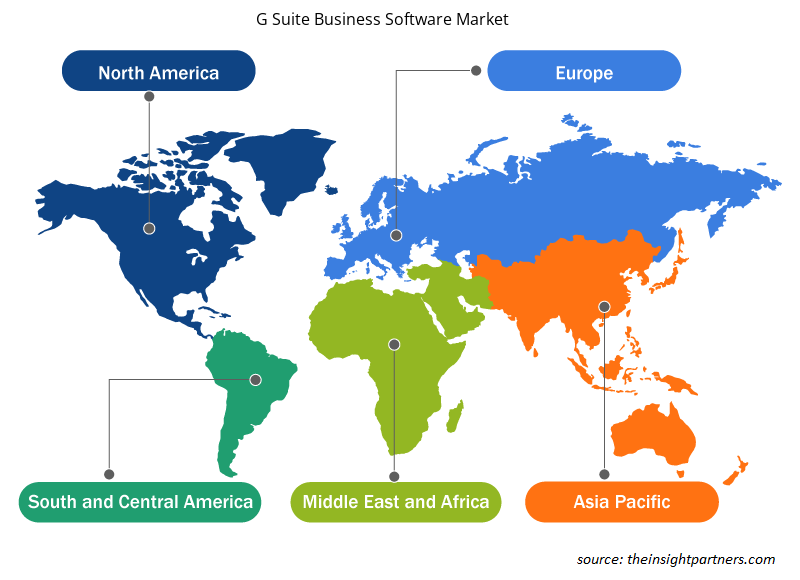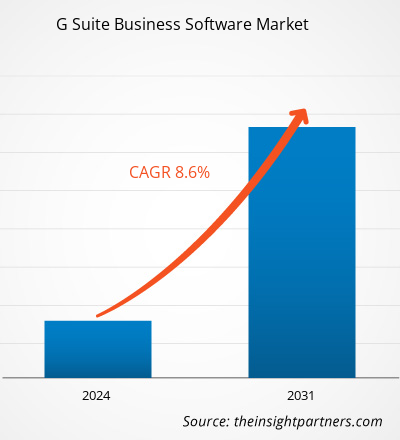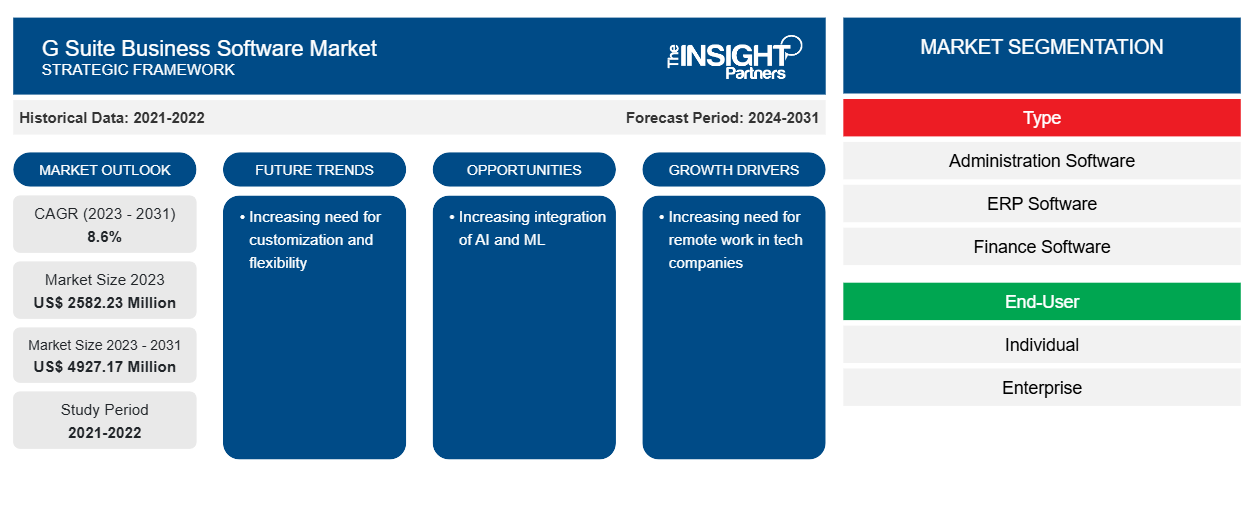Si prevede che la dimensione del mercato del software aziendale G Suite raggiungerà i 4927,17 milioni di dollari entro il 2031, rispetto ai 2582,23 milioni di dollari del 2023. Si prevede che il mercato registrerà un CAGR dell'8,6% nel periodo 2023-2031. La crescente necessità di personalizzazione e flessibilità rimarrà probabilmente una tendenza chiave nel mercato.CAGR of 8.6% during 2023–2031. The increasing need for customization and flexibility is likely to remain a key trend in the market.
Analisi di mercato del software aziendale G Suite
G Suite consente alle aziende e alle organizzazioni di utilizzare la suite di strumenti di produttività e collaborazione basati su cloud di Google alla fine dei loro processi aziendali. Vari sviluppatori e fornitori di soluzioni di terze parti offrono una governance e una gestione superiori delle soluzioni G Suite in base ai requisiti delle aziende. Calendly fornisce una soluzione per G Suite che funziona perfettamente con Google Calendar per gestire tutte le prenotazioni e le attività correlate alla pianificazione. Mixmax offre soluzioni di calendario e una piattaforma di produttività e-mail per vendite, successo dei clienti, reclutamento, operazioni di vendita, leadership e imprenditori. Le aziende di terze parti forniscono strumenti aggiuntivi per G Suite che migliorano la produttività e la gestibilità delle aziende e forniscono ai clienti requisiti personalizzati.
Panoramica del mercato del software aziendale G Suite
G Suite è una suite di applicazioni Software as a Service (SaaS) progettata e alimentata da Google. Queste app basate sul cloud si concentrano su diverse aree, come business, collaborazione, produttività e istruzione. Gmail, Docs, Sheets, Drive, Calendar, Google+, Slides, Forms, Sites, Hangouts e Keep sono i principali strumenti G Suite disponibili da Google. G Suite è una risorsa preziosa per le aziende e per i privati in tutto il mondo.
Personalizza questo report in base alle tue esigenze
Riceverai la personalizzazione gratuita di qualsiasi report, comprese parti di questo report, o analisi a livello nazionale, pacchetto dati Excel, oltre a usufruire di grandi offerte e sconti per start-up e università
-
Scopri le principali tendenze di mercato in questo rapporto.Questo campione GRATUITO includerà analisi di dati che spaziano dalle tendenze di mercato alle stime e alle previsioni.
Driver e opportunità di mercato del software aziendale G Suite
Crescente necessità di lavoro da remoto nelle aziende tecnologiche
I datori di lavoro sono sempre più interessati a posizioni presso aziende che offrono modelli di lavoro da remoto o ibridi e sempre più datori di lavoro stanno riconoscendo questa tendenza. Dal 2021 al 2022, un rapporto del sito web di annunci di lavoro FlexJobs.com ha rivelato che gli annunci per posizioni da remoto sono aumentati dal 12% dell'anno precedente al 12%. La popolarità del lavoro da remoto è diventata un fattore importante ed è probabile che aumenti man mano che i datori di lavoro affinano le loro politiche di assunzione sul lavoro da casa. Pertanto, la crescente necessità di lavoro da remoto nelle aziende tecnologiche sta guidando il mercato del software aziendale G Suite.FlexJobs.com revealed that listings for remote positions rose from 12% the previous year to 12%. The popularity of remote work has become a major factor and is likely to rise as employers refine their employment policies on working from home. Therefore, the increasing pen need for remote work in tech companies is driving the G suite business software market.
Crescente integrazione dell’IA
Con l'aiuto di AI e ML, G Suite aggiunge strumenti di sicurezza. Diverse aziende stanno implementando il software aziendale G Suite con tecnologie AI e ML. Ad esempio, nel 2020, il gigante della ricerca ha annunciato diversi aggiornamenti a G Suite utilizzando AI, il suo set di app che assomigliano a Google Docs e Sheets ma sono su misura per l'ufficio. L'azienda lo ha annunciato durante la sua conferenza annuale Google Cloud Next a San Francisco. Pertanto, la crescente integrazione di AI con il software aziendale G Suite sta creando più opportunità per il mercato.deployoing G suite business software with AI and ML technologies. For instance, in 2020, the search giant announced several updates to G Suite by using AI, its set of apps that resemble Google Docs and Sheets but are tailored for the office. The company announced this during its annual Google Cloud Next conference in San Francisco. Therefore, the increasing integration of AI with G Suite business software is creating more opportunities for the market.
Analisi della segmentazione del rapporto di mercato del software aziendale G Suite
I segmenti chiave che hanno contribuito alla derivazione dell'analisi di mercato del software aziendale G Suite sono la tipologia e l'utente finale.
- In base al tipo, il mercato del software aziendale G Suite è suddiviso in software di amministrazione, software ERP, software finanziario, software HR e altri. Il segmento personalizzato ha detenuto una quota di mercato maggiore nel 2023.ERP software, finance software, HR software, and others. The customized segment held a larger market share in 2023.
- In base agli utenti finali, il mercato è segmentato in privati, aziende e altri.
Analisi della quota di mercato del software aziendale G Suite per area geografica
L'ambito geografico del rapporto sul mercato del software aziendale G Suite è suddiviso principalmente in cinque regioni: Nord America, Asia Pacifico, Europa, Medio Oriente e Africa, Sud e Centro America.
L'APAC domina il mercato del software aziendale G Suite. Il mercato del software aziendale G Suite in questa regione sta crescendo a causa di vari fattori, come le crescenti iniziative delle organizzazioni per migliorare la loro sicurezza e la presenza di affermati fornitori dominates the G Suite business software market. The G suite business software market in this region is growing due to various factors, such as increasing organizations' initiatives to improve their security and the presence of well-established G suite business di software aziendale G Suite .
Approfondimenti regionali sul mercato del software aziendale G Suite
Le tendenze regionali e i fattori che influenzano il mercato del software aziendale G Suite durante il periodo di previsione sono stati ampiamente spiegati dagli analisti di Insight Partners. Questa sezione discute anche i segmenti e la geografia del mercato del software aziendale G Suite in Nord America, Europa, Asia Pacifico, Medio Oriente e Africa e America meridionale e centrale.

- Ottieni i dati specifici regionali per il mercato del software aziendale G Suite
Ambito del rapporto di mercato del software aziendale G Suite
| Attributo del report | Dettagli |
|---|---|
| Dimensioni del mercato nel 2023 | 2582,23 milioni di dollari USA |
| Dimensioni del mercato entro il 2031 | 4927,17 milioni di dollari USA |
| CAGR globale (2023-2031) | 8,6% |
| Dati storici | 2021-2022 |
| Periodo di previsione | 2024-2031 |
| Segmenti coperti |
Per tipo
|
| Regioni e Paesi coperti |
America del Nord
|
| Leader di mercato e profili aziendali chiave |
|
Densità dei player del mercato del software aziendale G Suite: comprendere il suo impatto sulle dinamiche aziendali
Il mercato del software aziendale G Suite sta crescendo rapidamente, spinto dalla crescente domanda degli utenti finali dovuta a fattori quali l'evoluzione delle preferenze dei consumatori, i progressi tecnologici e una maggiore consapevolezza dei vantaggi del prodotto. Con l'aumento della domanda, le aziende stanno ampliando le loro offerte, innovando per soddisfare le esigenze dei consumatori e capitalizzando sulle tendenze emergenti, il che alimenta ulteriormente la crescita del mercato.
La densità degli operatori di mercato si riferisce alla distribuzione di aziende o società che operano in un particolare mercato o settore. Indica quanti concorrenti (operatori di mercato) sono presenti in un dato spazio di mercato in relazione alle sue dimensioni o al valore di mercato totale.
Le principali aziende che operano nel mercato del software aziendale G Suite sono:
- SCANALATURA
- MAILTRACK.IO
- Calendulamente
- Società di consulenza NetHunt Inc.
- Mescolare Max
- Salesforce.com Inc.
Disclaimer : le aziende elencate sopra non sono classificate secondo un ordine particolare.

- Ottieni una panoramica dei principali attori del mercato dei software aziendali G Suite
Notizie di mercato e sviluppi recenti del software aziendale G Suite
Il mercato del software aziendale G Suite viene valutato raccogliendo dati qualitativi e quantitativi dopo la ricerca primaria e secondaria, che include importanti pubblicazioni aziendali, dati associativi e database. Di seguito sono elencati alcuni degli sviluppi nel mercato del software aziendale G Suite:
- Google ha rinominato G Suite, un set di strumenti di produttività e collaborazione online per le aziende che include Gmail, Drive, Docs e Meet. Il nuovo nome è Google Workspace, un nome che l'azienda aveva già accennato quando ha introdotto per la prima volta un set di nuovi strumenti di collaborazione e integrazioni di Google Meet per il servizio all'inizio di quest'anno. (Fonte: Google, comunicato stampa, ottobre 2020)
- G Suite di Google ha aggiunto nuovi strumenti di sicurezza e AI. Il gigante della ricerca ha annunciato diversi aggiornamenti a G Suite, il suo set di app che assomigliano a Google Docs e Sheets ma sono su misura per l'ufficio. (Fonte: Tungsram Group, comunicato stampa, luglio 2021)
Copertura e risultati del rapporto sul mercato del software aziendale G Suite
Il rapporto "Dimensioni e previsioni del mercato del software aziendale G Suite (2021-2031)" fornisce un'analisi dettagliata del mercato che copre le seguenti aree:
- Dimensioni e previsioni del mercato del software aziendale G Suite a livello globale, regionale e nazionale per tutti i segmenti di mercato chiave coperti dall'ambito
- Tendenze del mercato del software aziendale G Suite e dinamiche di mercato come driver, vincoli e opportunità chiave
- Analisi dettagliata delle cinque forze PEST/Porter e SWOT
- Analisi di mercato del software aziendale G Suite che copre le principali tendenze del mercato, il quadro globale e regionale, i principali attori, le normative e i recenti sviluppi del mercato
- Analisi del panorama industriale e della concorrenza che copre la concentrazione del mercato, l'analisi della mappa di calore, i principali attori e gli sviluppi recenti per il mercato del software aziendale G Suite
- Profili aziendali dettagliati
- Analisi storica (2 anni), anno base, previsione (7 anni) con CAGR
- Analisi PEST e SWOT
- Valore/volume delle dimensioni del mercato - Globale, Regionale, Nazionale
- Industria e panorama competitivo
- Set di dati Excel
Report recenti
Rapporti correlati
Testimonianze
Motivo dell'acquisto
- Processo decisionale informato
- Comprensione delle dinamiche di mercato
- Analisi competitiva
- Analisi dei clienti
- Previsioni di mercato
- Mitigazione del rischio
- Pianificazione strategica
- Giustificazione degli investimenti
- Identificazione dei mercati emergenti
- Miglioramento delle strategie di marketing
- Aumento dell'efficienza operativa
- Allineamento alle tendenze normative























 Ottieni un campione gratuito per - Mercato del software aziendale G Suite
Ottieni un campione gratuito per - Mercato del software aziendale G Suite